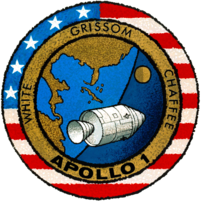Apollo 1 is the official name that was later given to the never-flown Apollo/Saturn 204 (AS-204) mission.
It's command module (CM-012) was destroyed by fire during a test and training exercise on January 27, 1967 at Pad 34 (Launch Complex 34, Cape Canaveral, then known as Cape Kennedy) atop a Saturn IB rocket.
The crew aboard were the astronauts selected for the first manned Apollo program mission: Command PilotVirgil I. "Gus" Grissom, Senior Pilot Ed White and Pilot Roger B. Chaffee. All three died in the fire.
Even though the ignition source of the fire was never conclusively identified, the astronauts' deaths were attributed to a wide range of lethal design hazards in the early Apollo command module.
Among these were the use of a high-pressure 100 percent-oxygen atmosphere for the test, wiring and plumbing flaws, flammable materials in the cockpit (such as Velcro), an inward-opening hatch that would not open in this kind of an emergency and the flight suits worn by the astronauts

A seven-member board conducted a comprehensive investigation to pinpoint the cause of the fire and
the final report was submitted to the NASA Administrator.
The report presented the results of the investigation and made specific recommendations that led to major design and engineering modifications, and revisions to test planning, test discipline, manufacturing processes and procedures, and quality control.
With these changes, the overall safety of the command and service module and the lunar module was increased substantially. The AS-204 mission was redesignated Apollo I in honor of the crew.
AS-204 was to be the first manned flight of a command and service module (CSM) to Earth orbit, launched on a Saturn 1B. CM-012, the Apollo 1 command module, was a Block I design built for spaceflight but never intended for a trip to the moon since it lacked the needed docking equipment.
The AS-204 mission was scheduled for the first quarter of 1967, having already missed a target date for the last quarter of 1966. The flight was to test "launch operations, ground tracking and control facilities and the performance of the Apollo-Saturn launch assembly" and would have lasted up to two weeks, depending on how the spacecraft performed.
Quick facts on Appolo 1
Launch Pad :Pad 34-A (7)Rocket: Saturn-1B AS-204 (4)CSM-x ()Apollo Pad FireCrew- Virgil I. "Gus" Grissom, Command Pilot
- Edward H. White II, Senior Pilot
- Roger B. Chaffee, Pilot
Backup crewsApril - December 1966
- James McDivitt, Command Pilot
- David Scott, Senior Pilot
- Rusty Schweickart, Pilot
This crew flew on Apollo 9.
- December 1966 - January 1967
- Walter Schirra, Command Pilot
- Donn Eisele, Senior Pilot
- Walter Cunningham, Pilot
This crew flew on Apollo 7.








0 comments:
Post a Comment